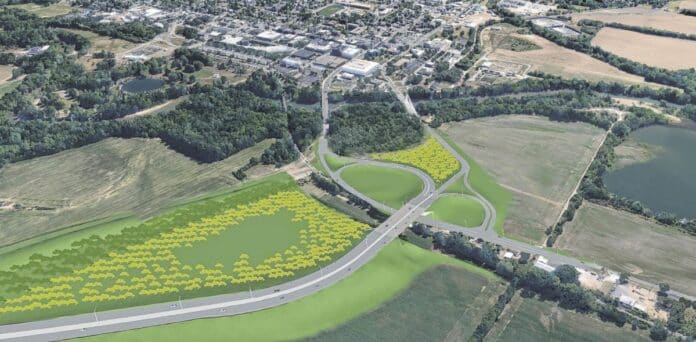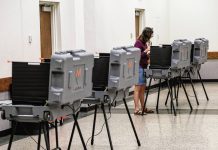
A long-awaited moment for city and county officials happens Monday when the groundbreaking ceremony for an estimated $35 million railroad overpass on Columbus’ west side will be celebrated.
The groundbreaking ceremony, which is open to the public, is planned at 4 p.m. Monday near the former Kocolene site, on the north side of State Road 46 just west of State Road 11.
The ceremony, which is expected to last about a half hour, will have comments from Columbus Mayor Jim Lienhoop, Cummins Vice President Tony Satterthwaite (president of the company’s Distribution Business), Louisville & Indiana Railroad President John Goldman, INDOT officials and Milestone Contractors President C.J. Potts, whose company won the contract with the state to construct the overpass. Rep. Greg Pence, R-Indiana, who is from Columbus, also plans to attend.
Several Columbus police officers will be directing traffic at the groundbreaking site to help people access the ceremony, Hayward said.
[sc:text-divider text-divider-title=”Story continues below gallery” ]
Actual construction for the overpass is scheduled to begin in mid-November, with Milestone starting the project by removing several hundred trees from the construction site, said Dave Hayward, executive director of public works/city engineer. This includes about 66 trees on the south side of the project and the trees along the railroad tracks.
While those trees are being removed, the project calls for 2,184 trees be planted as replacements. More than 600 of those trees are in the infill areas around the cloverleaf, including the south side of the project, Hayward said.
The new overpass and cloverleaf interchange on the west side at State Road 46 and State Road 11 will allow motorists to avoid being slowed or stopped because of increasing railroad traffic projected to occur on the Louisville & Indiana Railroad tracks which pass through Columbus. Louisville & Indiana has leased the tracks to CSX, and, after a massive rail improvement project, is planning to run high-speed rail on the line from Louisville to Indianapolis.
Louisville & Indiana Railroad officials earlier notified the city that longer, heavier and faster CSX trains will begin traveling through Columbus on L&I’s rail system beginning this month.
Louisville & Indiana Railroad and CSX Transportation won approval in April 2015 from the federal Surface Transportation Board to use L&I’s 106-mile mainline between Louisville and Indianapolis jointly and upgrade it from jointed steel rails to continuous welded ones.
The new rails would allow heavier and faster trains to move through Columbus and other cities along the rail line. The plan calls for CSX, which would invest $70 million to $90 million in improvements, to shift an estimated 13 to 15 trains per day to the L&I line, in addition to the L&I trains.
Examining the railroads’ plan, the federal agency’s Office of Environmental Analysis said the project would not significantly affect communities along the rail line.
However, mayors in cities along the railroad strongly disagreed, and Columbus officials began looking for an alternative fix.
A 2016 study by Indianapolis engineering firm American Structurepoint Inc., commissioned by the city, indicates as many as 22 trains may travel through the State Road 46/State Road 11 intersection, and other Columbus downtown intersections.
If there is a near constant presence of trains on the downtown tracks, it will mean inconvenience for people who want to access Mill Race Park, Mill Race Center or the city bus depot, all on the west side of the tracks from Lindsey Street, city officials said.
Goldman, however, said in an earlier interview that economic factors will determine how many trains travel on the lines, which is currently at about eight trains a day.
“It could be more trains one month, or it could be fewer,” Goldman said in an earlier interview. “A lot will depend on the economy.”
Substantial completion of the overpass project is expected by the end of 2020. Hayward said earlier that landscaping and other finishing work will continue through 2021.
Columbus has approved the creation of a non-reverting fund to pay for the overpass.
The cost is being divided between the city and the Indiana Department of Transportation, each agreeing to pick up half of the total cost. But the city has other partners.
Bartholomew County will pay $1.5 million to the city and another $500,000 that will be paid over a two-year period. The city’s share will include $4 million from Central TIF District funds, while other funding sources include about $5.5 million from the Cummins Engine Plant TIF District funds, up to $2.5 million in state or federal highway programs along with cost savings and $1.5 million from CSX and Louisville & Indiana Railroads.
As construction begins on the overpass, west-side motorists are being advised to consider using County Road 325W and Lowell Road, a popular bypass that goes into southbound U.S. 31 and into the city’s business district on National Road.
Bartholomew County’s highway crews spent $200,000 to significantly soften two sharp curves on Lowell Road. That allowed the speed limit to be raised from 20 to 40 mph in that area in anticipation of both Lowell and 325W being used to avoid long waits for trains.
[sc:pullout-title pullout-title=”If you go” ][sc:pullout-text-begin]
What: Railroad Overpass Project groundbreaking celebration
When: 4 p.m. Monday
Where: Near the former Kocolene site on the north side of State Road 46 just west of State Road 11.
Who: Open to the public
[sc:pullout-text-end]




